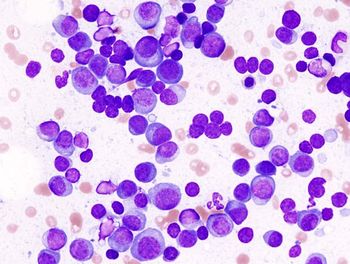
- Oncology Vol 28 No 1S
- Volume 28
- Issue 1S
(P150) Assessment of Acute and Late Toxicities of Intracranial Stereotactic Radiosurgery in Multiple Sclerosis Patients
Several reports over the last few decades have documented treatment-related toxicity or acceleration of demyelination in patients with multiple sclerosis (MS) treated with external beam radiotherapy. We propose to conduct a study investigating the acute and late toxicities of radiosurgery in MS patients in order to determine the risks associated with this modality in MS patients.
Sarah E. James, MD, PhD, Robert Foote, MD, Nadia Laack, MD, Michael J. Link, MD, Bruce E. Pollock, MD, Scott Stafford, MD, Robert Miller, MD, Yolanda Garces, MD, Ian Parney, MD; Department of Radiation Oncology, Department of Neurosurgery, Mayo Clinic
Background: Several reports over the last few decades have documented treatment-related toxicity or acceleration of demyelination in patients with multiple sclerosis (MS) treated with external beam radiotherapy. Therefore, great caution has been taken using radiation therapy (RT) in MS patients. Stereotactic radiosurgery (SRS) has been proposed to be a safe and effective option for treating intracranial tumors in MS patients. Only a very limited amount of data are available concerning SRS-related toxicities in MS patients. The present published data suggest that MS patients may be at higher risk of developing rare and high-grade toxicities secondary to radiosurgery; however, these data constitute results from a limited number of patients. We propose to conduct a study investigating the acute and late toxicities of radiosurgery in MS patients in order to determine the risks associated with this modality in MS patients.
Methods: Electronic medical records were reviewed to identify MS patients treated with GammaKnife radiosurgery at Mayo Clinic between January 1997 and August 2011. Information concerning target location and size were recorded, as well as treatment-related factors, such as target volume, maximum dose, and margin (target) dose. Toxicities were graded using the Radiation Therapy Oncology Group (RTOG) Acute/Late Radiation Morbidity Scoring Criteria and Common Terminology Criteria for Adverse Events version 4 (CTCAE v4).
Results: Eleven patients were identified with proven diagnosis of MS who subsequently underwent SRS for an intracranial lesion. Median age of patients was 58 years. Seventeen distinct targets were treated in among this cohort of patients. The targets of RT included the trigeminal nerve, acoustic neuroma, meningioma, and metastatic non–small-cell lung cancer. The target doses varied according to target. Trigeminal nerve doses ranged from 55–90 Gy. Acoustic neuroma dose was 24–25 Gy. One patient with meningioma was treated with 32 Gy to the target. Metastatic disease was treated with 40 Gy. Median follow-up for patients was 301 days. Only one patient experienced an acute toxicity of headache-a grade 1 toxicity. No patients experienced late toxicity.
Conclusion: In this cohort of patients, only a grade I acute toxicity was experienced with RT. The results of our study indicate that SRS is a safe treatment modality for use in patients with MS.
Articles in this issue
Newsletter
Stay up to date on recent advances in the multidisciplinary approach to cancer.

















































































